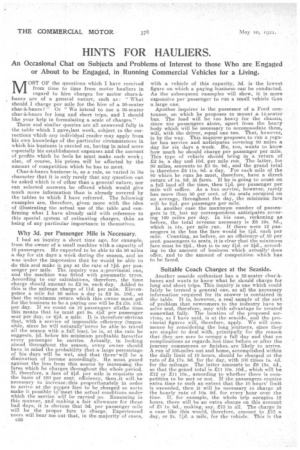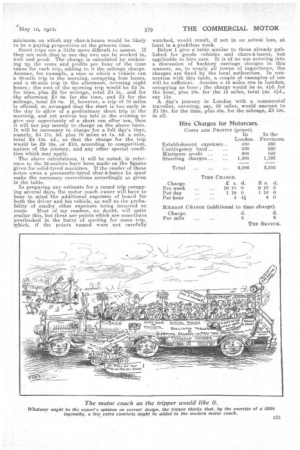HINTS FOR HAULIERS.
Page 26

Page 27

If you've noticed an error in this article please click here to report it so we can fix it.
An Occasional Chat on Subjects and Problems of Interest to those Who are Engaged or About to be Engaged, in Running Commercial Vehicles for a Living.
MOST OF the questions which I have received from time to time from motor hauliers in regard to hire charges for motor chars-abanes are of a. general nature, such as : " What should I charge per mile for the hire of a 30-seater char-a-banes? " Or "We intend to use a 30-seater char-a-banes for long and short trips, and I should like your help in formulating a scale of charges."
These and similar queries are all answered fully in the table which I gavetlast week, subject. to the corrections which any individual reader may apply from his own knowledge oi the particular circumstances in. which his business is carried on, having in mind more especially his establishment expenses and the amount of profits which he feels he must make each week ; also, of course, his prices will be affected by the amount of competition which he has to meet.
Char-k-bancs business-is, as a rule, so varied in its character that it ia only rarely that any question can be asked which is of other than a general nature, nor can selected answers be offered which would give ranch more information than is already covered by the tables to which I have referred. The following examples are, therefore, given more with the idea of illustrating the actual use of the table and confirming what I have already said with reference to this special system of estimating charges, than as being of any particular importance in themselves.
Why 3d. per Passenger Mile is Necessary,
I had an inquiry a short time ago, for example, from the owner of a small machine with a capacity of 10 passengers. He expected to be able to do 50 miles a day for six days a week during the season, and he was under the impression that he would he able to do this and make it pay at the rate of lfd. per passenger per mile. The inquiry was aa.provincial one, and the machine was fitted with pneumatic tyres. According to our calculations, therefore, the time charge should amount to £2 Bs. each day. Added to this is the mileage charge of 11d, per mile. Elevenpence a mile for 50 miles a day is 22 5s. 10d., so that the minimum return which this owner must get for the business to be a paying one will be 2413s. 10d. per day. If we count on 10 passengers allothe time this means that he must get 9s. 40: per passenger seat per day, or 21d. a mile. It is therefore,obvious that, with a service of impossible efficiency (impossible, since he will naturally-never be able to travel all the season with a full bus), he is, at the rate he suggests, 4c1. below his minimum profitable faresqor every passenger he carries. Actually, in looking ahead throughout the season, every owner should have in mind the probability thata large percentage of his days will be wet, and that there will be. a diminution of income accordingly. He must guard against, the loss from this source by increasing the fares which he charges throughout the whole period. If, therefore, a fare of ad. per mile is requisite on the basis of 100 per cent. efficiency, then,it will,be necessary to increa,se,this proportionately in order to arrive at the proper fare to be charged so asrtn make it possible lo'naeet the actual conditions under which the service will be carried on. .Reasbning in this manner, and making a fair allowance for these bad days, it is obvious that 3d. per passenger mile will be the proper fare to charge. Experienced users will bear' me out that, in the majority of cases,
e30 with a vehicle of this capacity, 3d. is the lowest figure on which a paying business can be conducted. As the subsequent examples will show, it is more expensive per passenger to run a small vehicle than a large one. Apother inquirer is the possessor of a Ford onetonner, on which he proposes to mount a 14-seater bus. The load will be too heavy for the chassis, since the passengers alone, apart from the heavy body which will be necessary to accommodate them, will, with the driver, equal one ton. That, however, is by the way. This inquirer proposes to run aregular bus service and anticipates covering 80 miles a day for six days a week. He, too, wants to know how much he should charge per passenger per mile. This type of vehicle should bring in a return of 22 5s. a day and 10d. per mile run. The latter, for 80 miles, amounts to 2,3 6s. 8d., and the grand total is therefore 25 11s. 8d. a day. For each mile of the 80 which he runs he must, therefore, have a direct return of is. 5d. in. fares. If he is going to count on a full load all the time, then lid. per passenger per mile will suffice. As a bus service, however, rarely has more than 50 per cent, of its seats occupied on an average, throughout the day, the minimum fare will be 2id. per passenger per mile. In another case the maximum number of passengers is 12, but my correspondent anticipates covering 100 miles per day. In hi a case, reckoning as before, the total revenue necessary is 26 19s. 8d., which is 14s. per mile run. If there were 12 passengers in the bus the fare would be lid. each per mile. Counting, as before, on an efficiency' of 50 per cent. passengers to seats, it is clear that the minimum fare must be 20., that is to say 21d. or 20., according to the amount. of business which actually' does offer, and to the amount of competition which has to be faced.
Suitable Coach Charges at the Seaside.
Another seaside enthusiast has a 32-seater char-abanes and wants to know what he should charge for long and short trips. This inquiry is one which could fairly be termed a general one, as all the necessary information required for its answer is contained in the table. It is, however, a real sample of the sort of problem that newcomers to the industry have to solve and, therefore, may with advantage be treated somewhat fully. The location of the. proposed services, as I have said, is at the seaside, and the provincial figures will, therefore, apply. We will commence by considering the long journeys, since they are simpler to deal with, principally for the reason that they are sure to occupy a full day and that no complications as regards lost time before or after the journey commences or finishes, are likely to arrive. A run of 100.miles out and home accomplished within the daily limit of 10 hours, should be charged at the rate of £4 17s. 6d. for the day, with 100 times is. 4d. for the mileage. The latter amounts to £6 13s. 4d., so that the grand total is £11 10s. 10c1., which will be £12 or £11 10s., according to whether there is competition to be met or not. If the passengers. require extra. time to such an extent that the 10 hours' limit is exceeded, then it will be necessary to charge at the hourly rate of 108. 9d. for every hour over the time If, for example, the whole trip occupies 12 hours, there will be an extra charge on this account of £1 is. fid., making, say, 213 in all. The charge in a case like this would, therefore, amount to 213 a day, or 2s. 7W. a mile, for the vehicle. This is the minimum• on which any char-b,bancs would be likely to be a paying proposition at the present time.
Short trips are a little more difficult to assess. If they are such that in one day two can be worked in, well and good. The charge is calculated by reckoning up the costs and profits per hour of the time taken for each trip, adding to it the mileage charge. Assume, for example, a case in which a vehicle ran a 30-mile trip in the morning, occupying four hours, and a 60-mile trip in the afternoon, covering eight hours; the cost of the morning trip would be 22 3s. for time, plus 22 for mileage, total £4 3s., and for the afternoon 24 6s. for the time, and 24 for the mileage, total 28 Os. If, however, a trip of 70 miles is offered, so arranged that the start is too early in the day to allow of a preliminary short trip in the morning, and yet arrives too late in the evening to give any opportunity of a short run after tea, then it will not pay metely to charge on the above basis. It will be necessary to charge for a full day's time, namely, 17s. 6d. plus 70 miles at is. 4d. a mile, total 24 13s. 4d., so that the charge for the trip would be 29 10s. or 210, according to competition, nature of the journey, and any other special condition which may apply.
The above calculations, it will be noted, in reference to the 32-seaters have been made on the figures given for solid-tyred machines. If the reader of these notes owns a pneumatic-tyred char-h-banes he must make the necessary corrections accordingly as given in the table.
In preparing any estimate for a round trip occupying several days, the motor coach owner will have to bear in mind 'the additional expenses of board for both the driver and his vehicle, as well as the probability of sundry other expenses being incurred en
route. Most of my readers, T1O doubt, will quite realize this, but these are points which are sometimes 'overlooked in the hurry of quoting for some trip, hich, if the points named were not carefully watched, would result, if not in an actual loss, at least in a profitless week. Below 1 give a table similar to those already published for goods vehicles and ehars-a-bancs, but applicable to hire ears. It is of no use entering into a discussion of hackney carriage charges in this manner, as, in nearly all towns of importance, the charges are fixed by the local authorities. In connection with this tablez a couple of examples of use will be sufficient. Assume a lo miles run in London, occupying an hour; the charge would be 4s. 40. for the hour, plus 10s. for the 15 miles, total 14s. 40., say 15s.
A day's journey in London with a commercial traveller, covering, say, 60 miles, would amount to El 19s. for the time, plus 40s. for the mileage, £3 19s, in all.
































